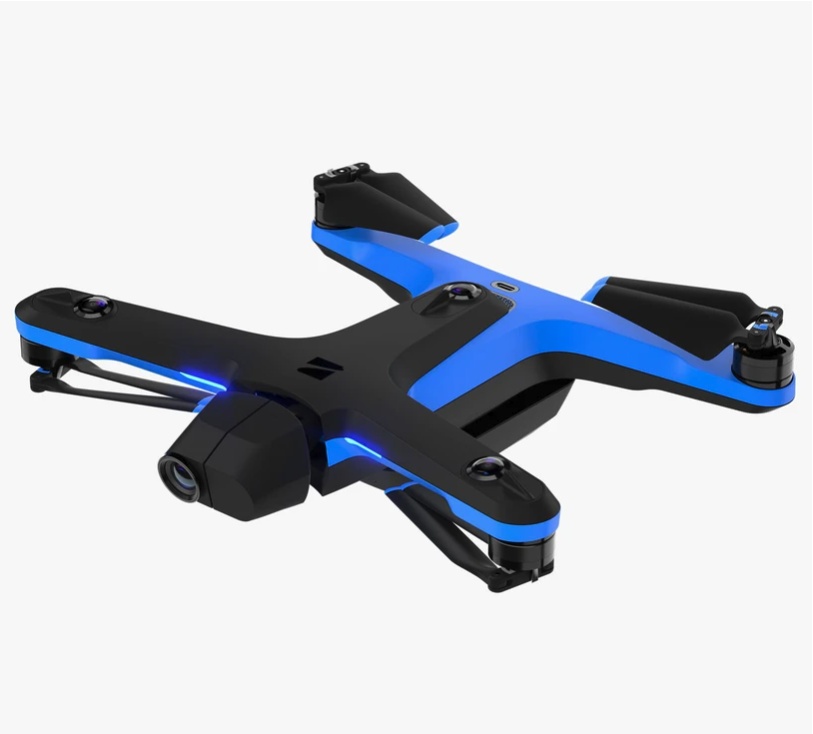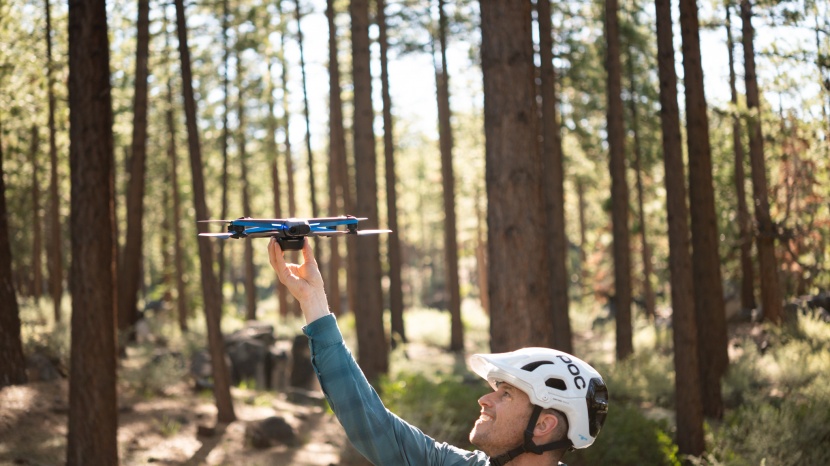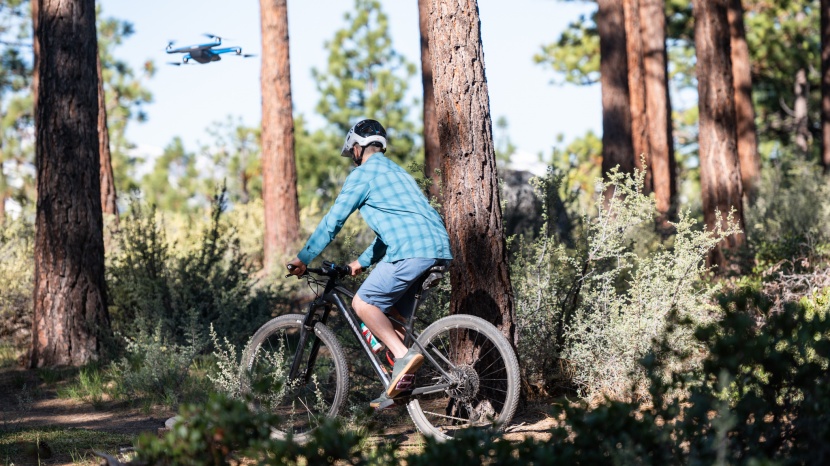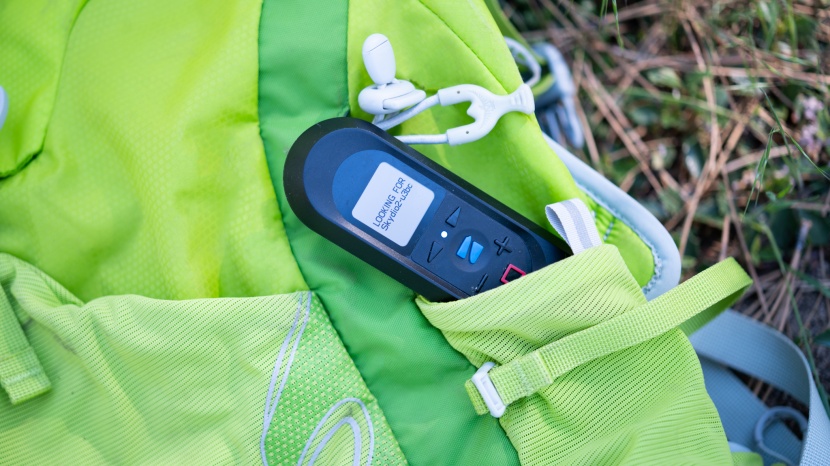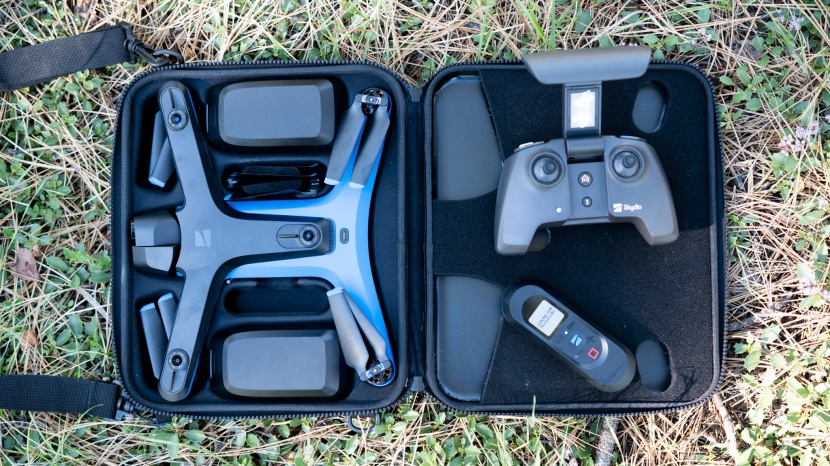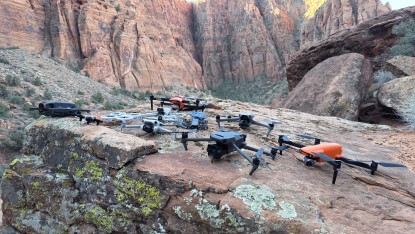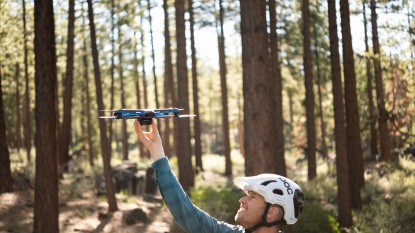Skydio 2 Review

Our Verdict
Our Analysis and Test Results
The Skydio 2 is the best drone available for those looking to film themselves while out adventuring. You can also buy the beacon accessory to make the subject tracking more convenient and reliable, and you can purchase a controller for more classic and cinematic drone shots. Though the autonomous flight modes still have some limitations, those limitations are far fewer than with any other drone on the market. We recommend this drone to people that mostly want autonomous flight modes while leaving the option open for occasional manual flight.
Video Quality
The 4K camera on the Skydio 2 provides impressively clear, crisp footage, representing a big improvement over its predecessor. In our tests, the camera consistently churned out high-quality footage with good resolution and pleasing color composition. In ideal lighting conditions, this footage is nearly on par with that of some of DJI's upper-tier prosumer models. The biggest weak point of this drone's camera comes with cloudy, low-light conditions. In those circumstances, colors can start to look a bit dull and muted — if the drone even allows you to fly at all (if it senses that there isn't enough light for its obstacle avoidance cameras to function well, it will not take off).
One thing to note is that while the Skydio 2 can produce fantastic images in good lighting conditions, it lacks many of the advanced options of the upper-level DJI models. This means there are fewer post-processing options for serious hobbyists who might want to do some advanced editing like color correction.
The camera on the Skydio 2 can shoot 60 frames-per-second (fps) at its full 4K resolution, meaning you can get some cool slow-motion effects even when shooting in ultra-high definition. If you drop the resolution down to 1080p high definition, the maximum frame rate increases to 120 fps, allowing you to dip your toe into super slow-motion territory. There are also the standard options for 24 and 30 fps in both resolutions.
Flight Performance
As mentioned, the autonomous flight performance from this drone is top-notch. Its manual flight performance is serviceable but leaves a bit to be desired.
Autonomous Flight Performance
The Skydio 2 is designed to be a drone that flies itself, and in that capacity, it is the best in the field. We took it skiing, mountain biking, and running. In all cases, its autonomous follow mode kept up with the subject, kept the subject in frame, and avoided obstacles much more adeptly than any other model on the market. The drone offers two modes with which to autonomously follow a subject. The first is motion track, which will always follow a subject from the same angle in relation to the subject's direction of motion. For example, if you set the drone to follow you from behind and then turn around, the drone will rush to get back around behind you again. The second mode is fixed track, which continues to follow from the starting angle regardless of the subject's direction of motion. In this mode, if you start with the drone following you from behind and then turn 180˚, it will stay in the same position and continue to follow you, but now from the front. The Skydio rounds out its autonomous flight functions with dronie, orbit, cable cam, hover (tripod follow mode) rocket, boomerang, and vortex modes.
If the main thing you want your drone to do is follow you or other subjects autonomously, this is the drone for you as it does this better than any other model on the market. However, it still doesn't do this perfectly, and we're going to point out some of the imperfections we experienced in our testing, so you don't purchase this drone with unrealistic expectations.
At lower speeds, certain capabilities of this drone are near impeccable. When we used it to follow a runner, it confidently flew through gaps in trees that we would be very scared to attempt with manual controls, all while keeping the subject perfectly in the center of the frame. Impressive. However, when going downhill on a mountain bike or skis, we often saw the subject drifting to the edges of the frame and often completely out of the frame, causing the drone to lose visual tracking. These problems become worse with higher speeds and denser obstacles. When the drone loses visual tracking, it will stop and hover, requiring that you get back into its field of view or manually fly it to you with your phone before it will track you again. If you've purchased the beacon accessory and have it on your person, the drone can use the GPS within the beacon to continue to follow you, even when you leave its view. In our testing, this worked some of the time, but even while using the beacon, we ran into instances when we had to go and manually recover the drone once it lost visual tracking.
All Skydio 2 drones are shipped with a height floor restriction enabled by default. This feature prevents the drone from dipping below 8 feet in altitude while in an autonomous flight mode. Therefore, if you pass an obstacle that would require the drone to fly below 8 feet to avoid, the drone will simply stop where it is. If you frequently find yourself in such situations, you can turn the height restriction off.
Manual Flight Performance
If you don't purchase any accessories, you must use an app on your phone that utilizes virtual joysticks to fly the Skydio 2manually. This severely limits the range and nimbleness of the drone and is really only useful for getting it into position before engaging one of the autonomous flight functions.
If you purchase the Skydio controller, you get an extended range and physical joysticks that allow for much better overall control. You can also plug your phone into the controller to access a real-time video feed while you fly. This setup will enable you to fly the drone further afield and get more classic, landscape-style drone shots. However, while the controller's specs claim this gives you a range of over two miles, we found that range to be much less in practice. We experienced dropped frames in the video feed and even momentary losses of connection with the drone comfortably within half a mile of the controller, even in areas with few physical obstacles and little to no RF interference. Additionally, the shorter joysticks make the execution of more fine-tuned maneuvers much more difficult than with the longer joysticks found on competing controllers.
The drone's obstacle avoidance remains active during manual flights. While this is nice, we felt like the drone trusted itself more than a human pilot in our tests, seemingly dipping and dodging even when a safe distance from an obstacle. Bottom line, we think the controller provides the option to get the drone up a little higher to record an establishing shot before bringing it back down and engaging follow mode for the rest of your mountain biking or skiing adventure. If you're getting a drone mostly for manual flying, we think you'll likely find the controller and the experience it offers frustrating and limiting.
Do You Need the Beacon?
The Skydio 2 offers good motion tracking without the beacon, but we think the beacon does improve the experience. First off, it allows you to get the drone in the air and following you without using your phone, a nice feature for those adventures where you want to keep your phone in your backpack for safekeeping. We can't definitively say that the beacon improves the drone's tracking ability, but we do anecdotally think it allowed the drone to better recover from the subject moving to the extreme edge of the frame.
Low Light Flying Restrictions
It's important to keep in mind that the obstacle avoidance cameras on the Skydio 2 are optical rather than infrared, like those on most competing models. This means a lack of light can affect their performance. If the drone senses that there is too little light for its obstacle avoidance cameras to work properly, it will not allow you to take off. While we never experienced any issues with this, some users have reported the drone refusing to take off in overcast conditions.
Ease of Use
We found using the follow functions and other autonomous flight modes to be quite easy. However, we docked some points here because you must buy additional accessories to unlock some of its capabilities.
The Skydio 2 app makes getting the drone in the air and following a subject quite intuitive. After some painless initial setup, you can pretty much press takeoff, get yourself or another subject in view of the camera, highlight that subject on your phone, and you're off to the races.
If you want to purchase either the beacon or controller accessories, linking those to the drone is likewise painless. The beacon does keep its controls fairly spartan in order to maintain a slim profile. While this is appreciated, it also means you'll likely have to flip through the manual to figure out exactly what each button does.
The Skydio 2 requires a micro SD card that is at least class 3. This means the card has a minimum write speed of 30 mb/s and is denoted by a letter “U” with a small “3” inside of it. We made the mistake of putting a slightly slower card into the drone. Somewhat frustratingly, we didn't get an error message saying, “memory card too slow,” the drone just performed very poorly. It took us some research to figure out what was wrong. A simple error message would have made the process much easier, and a more conspicuous statement of the memory card requirements would have circumvented the issue.
Portability
Unlike its predecessor, the Skydio 2 can fit into most backpacks. Also unlike its predecessor, it comes with a protective carrying case that can hold the drone, two batteries, and the beacon accessory.
While this makes the Skydio 2 much more portable than the model that came before it, it does not fold up like some competing drones. This is understandable, as moving parts could mess up the alignment of the obstacle avoidance cameras, which need to be impeccable. However, it makes the drone much less packable than competing DJI models.
Value
The Skydio 2, whether you buy any of its accessories or not, lies towards the more expensive end of the spectrum. If you're looking for the best autonomous flight features available, we think that price is well worth it. For those that want to do more manual flying and have more control when framing sweeping, cinematic shots, this drone may not be the best bang for the buck.
Conclusion
For those seeking a drone that can autonomously follow them during their outdoor adventures, the Skydio 2 is a worthy companion. If you want to get some more classic drone shots as well, you can even get the optional controller to do some limited manual flying. However, if autonomous following isn't #1 on your priority list, this likely isn't the drone for you.


